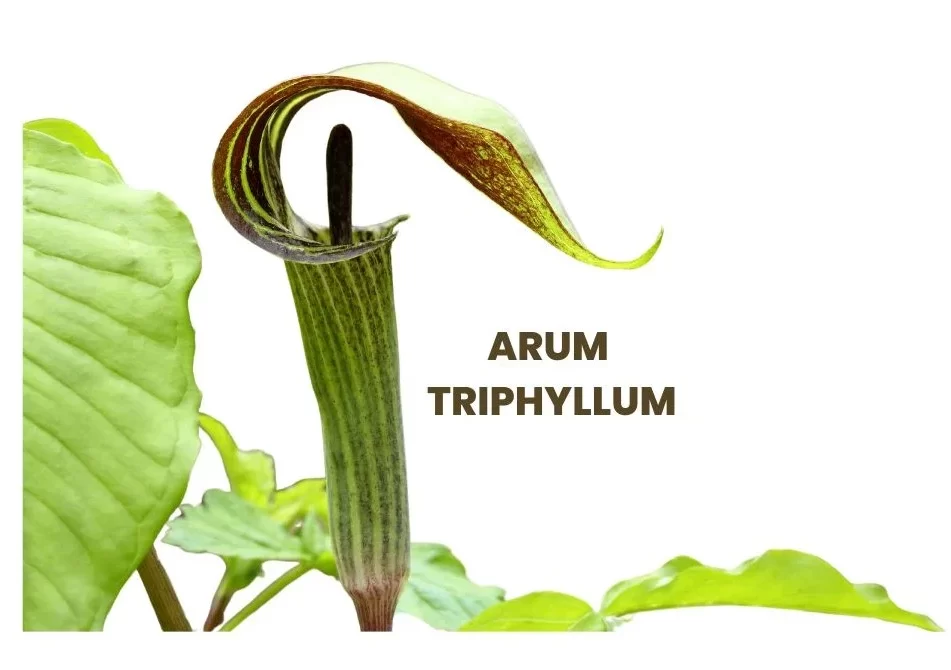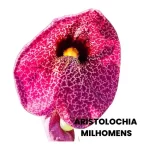Arum Triphyllum, a member of the Arum family, stands out as a crucial remedy, particularly in addressing acute colds.
Other Arum species, including Arum maculatum, Italicum, and Dracontium, share similar actions, containing an irritant poison that induces inflammation of mucous surfaces and tissue destruction.
The characteristic feature of Arum remedies is their acrid nature.
PROVER– DR. JEANES

Table of Contents
ToggleSOURCE INFORMATION
- Botanical Name: Arum Triphyllum
- Family: Araceae
- Common Names: Indian Turnip, Jack-in-the-Pulpit
Botanical Features
- Leaves: The plant features three-part leaves, and the central stalk of the leaf is known as the “Jack” or “Pulpit.”
- Flower: The flower is enclosed in a hood-like structure called a spathe, resembling a preacher in a pulpit, which gives rise to the common name “Jack-in-the-Pulpit.”
- Fruit: The plant produces berries after flowering.
Habitat: Arum Triphyllum is typically found in woodland areas, preferring shaded and damp environments.
It is known for its ability to thrive in rich, moist soils.
CLINICAL APPLICATIONS
Arum Triphyllum finds clinical utility in various conditions such as aphonia, coryza, diphtheria, headaches, sore mouth (especially in scarlatina), typhoid, clergyman’s sore throat, glandular swellings, and cracked tongue.
SPHERES OF ACTION & PATHOGENESIS
- Left-Sided Affinity: Arum Triphyllum prominently influences the left side of the body.
- Mucous Membranes: It exerts a marked effect on the mucous membranes of the mouth, throat, and larynx.
- Multiple Organs: This remedy extends its action to the kidneys, brain, blood, and skin.
- Irritant Poison: Arum Triphyllum, with its irritant poison, triggers excitability and irritability in both the mind and body.
- Inflammation and Tissue Destruction: The remedy induces inflammation in mucous surfaces, leading to tissue destruction.
- Acrid Discharges: Discharges from affected areas are acrid, causing pain, soreness, raw sensations, and burning.
GUIDING SYMPTOMS
- Constant Picking at Nose: Continuous picking at the nose, causing it to bleed, with a tendency to bore into the side of the nose.
- Lip Picking Until Bleeding: Compulsive picking of the lips until they bleed, accompanied by cracked and bleeding corners of the mouth.
- Acrid, Ichorous Discharges: Presence of acrid and ichorous discharges that have an excoriating effect on mucous surfaces.
- Sore, Raw, and Burning Sensations: Parts affected by the condition are painfully sore, raw, and experience a burning sensation.
- Nasal Discharge and Stopped Nose: Despite watery discharge, there is a sensation of nasal obstruction or a feeling that the nose is stopped.
- Aphonia After Exposure to Winds and Singing: Complete loss of voice (aphonia) following exposure to northwest winds (similar to Aconite and Hep.) and from singing (similar to Argentum Nitricum and Causticum).
- Fluent Coryza with Raw Nostrils: Profuse and fluent coryza accompanied by raw nostrils.
- Refusal of Food and Drink in Children: Children refuse to consume food and drink due to soreness in the mouth and throat.
- Raw and Bleeding Tongue and Buccal Cavity: The tongue and the inner lining of the mouth are raw and bleeding, accompanied by profuse acrid salivation.
- Ailments From Various Causes: The condition may arise from exposure to northwest wind, catching cold, and overuse of the voice.
PARTICULARS
MIND SYMPTOMS IN CHILDREN
Children under the influence of Arum Triphyllum display distinctive mental symptoms:
- Excessive Crossness and Stubbornness: These children manifest heightened levels of irritability, often displaying a marked tendency towards cross and stubborn behavior.
- Nervousness: There is a noticeable state of nervousness observed in affected children. They may exhibit restlessness and an overall uneasy demeanor.
- Restlessness: Restlessness is a prominent feature in the mental state of these children. They may find it challenging to remain still or settled.
- Irritability: A general state of irritability characterizes their mental disposition. Small or routine matters may provoke disproportionate reactions.
- Persistent Habits: These children develop repetitive and persistent habits, such as boring into the nose or incessantly picking at the lips.
This behavior is focused on a specific spot until it results in soreness or bleeding.
MOUTH
- Painfully Raw and Inflamed Mouth: The mouth is in a state of intense rawness, soreness, and inflammation, causing significant discomfort.
- Cracked and Bleeding Corners of the Mouth: The corners of the mouth exhibit cracks and may bleed. This condition adds to the overall discomfort and distress.
- Profuse Acrid Saliva Secretion: There is an excessive and acrid secretion of saliva, which has a corrosive effect on the mucous membranes of the mouth. This contributes to the overall discomfort.
- Persistent Picking and Boring: Patients, despite the pain, engage in persistent picking and boring into the raw and bleeding surfaces of the mouth. This behavior is particularly noteworthy in conditions like diphtheria, scarlet fever, and typhoid.
- Tongue Issues: The tongue is cracked and may bleed. This further adds to the challenges in the oral cavity.
- Refusal of Food and Drink by Children: Due to the soreness in the mouth and throat, children affected by Arum Triphyllum refuse to consume food and drink.
NOSE
- Acrid and Fluent Nasal Discharge: During an acute cold, the nasal discharge is acrid and flows freely. Stuffy Nose Despite Watery Discharge: Despite a watery discharge, the nose feels congested, necessitating the patient to breathe through the mouth.
- Night-Worsened Sneezing: Sneezing tends to worsen at night, contributing to discomfort during sleep.
- Constant Nose Picking Until Bleeding: A characteristic behavior involves constant picking at the nose, often to the extent of causing bleeding.
- Boring with the finger into the side of the nose is another notable feature.
THROAT
- Raw and Sore Throat: The throat is raw, sore, and painful, particularly when clearing the throat or coughing. This discomfort often makes swallowing difficult for the patient.
- Ideal for Clergymen’s Sore Throat: Particularly indicated for clergymen’s sore throat or individuals who engage in extensive speaking, such as orators, singers, and actors.
- Hoarse and Uncertain Voice: The voice becomes hoarse, uncertain, and uncontrollable. It undergoes continual changes, contributing to communication challenges.
- Complete Aphonia from Specific Triggers: Complete loss of voice (aphonia) occurs after exposure to northwest winds or from excessive singing.
- Modality: Symptoms worsen when the individual engages in talking, speaking, or singing activities.
GENERAL MODALITIES
- Overuse of Voice: Symptoms worsen with excessive talking or singing, indicating strain on the vocal cords.
- Talking and Singing: Engaging in vocal activities aggravates the symptoms.
- Exposure to Northwest Wind: The condition worsens after exposure to cold northwest winds.
- Heat: Symptoms are exacerbated in hot environments.
- Lying Down: Discomfort increases when lying down.
- Night: Symptoms tend to worsen at night, possibly affecting sleep quality.
WHAT ARE MODALITIES IN HOMOEOPATHY?
RELATIONS
Useful After
- Hep. and Nit. Acid: Useful in treating hoarse, croupy cough.
- Caust. and Hep.: Effective after these remedies for morning hoarseness and deafness, as well as in scarlet fever cases.
DOSE
Administer in potencies ranging from third to thirtieth potency, as per homeopathic prescribing principles.
FREQUENTLY ASKED QUESTIONS
1.What is Arum Triphyllum used for in homeopathy?
- Arum Triphyllum is a homeopathic remedy primarily used for acute colds, addressing symptoms such as sore throat, nasal congestion, and hoarseness.
- It is also indicated for conditions like aphonia, coryza, diphtheria, headaches, and scarlatina.
2. Are there specific conditions that Arum Triphyllum is known to benefit?
- Yes, Arum Triphyllum is particularly beneficial for clergyman’s sore throat, where individuals engage in extensive speaking.
- It is also useful for sore throat in orators, singers, and actors.
- Additionally, it addresses various symptoms related to the mucous membranes, such as cracked tongue and glandular swellings.
3. What distinguishes Arum Triphyllum from other Arum species like Arum maculatum and Arum Dracontium?
- Arum Triphyllum shares similar actions with other Arum species, all containing an irritant poison that affects mucous surfaces and leads to tissue destruction.
- The distinguishing feature is their acrid nature, with symptoms being characterized by soreness, rawness, and burning sensations.
4. Can Arum Triphyllum be used for children?
- Yes, Arum Triphyllum is indicated for children who display symptoms of excessive crossness, stubbornness, nervousness, restlessness, and irritability.
- It is especially relevant when children exhibit persistent habits like picking the nose or lips until they bleed.
5. How does Arum Triphyllum affect the mouth and throat?
- In the mouth, Arum Triphyllum causes intense rawness, soreness, and inflammation.
- The corners of the mouth may crack and bleed, and there is profuse acrid saliva secretion, contributing to discomfort.
- Throat symptoms include rawness, soreness, and difficulty swallowing, making it beneficial for clergymen’s sore throat.
MEANING OF DIFFICULT WORDS
- Acrid: Having a sharp, pungent, or bitter taste or smell.
- Ichorous: Thin, watery, and acrid discharge, often referring to discharges from wounds.
- Excoriating: Abrading or wearing off the skin; causing irritation.
- Aphonia: Loss of voice or inability to speak.
- Spathe: A large bract or pair of bracts forming a sheath to enclose the flower cluster of certain plants.
- Potency: The strength or effectiveness of a remedy in homeopathy.
- Coryza: Inflammation of the mucous membrane in the nose, often accompanied by a runny nose.
- Deafness: Partial or complete loss of the ability to hear.
- Ailments: Physical disorders or illnesses.
- Modality: Factors that affect the intensity or character of symptoms, such as time, temperature, and motion.













Leave a Reply